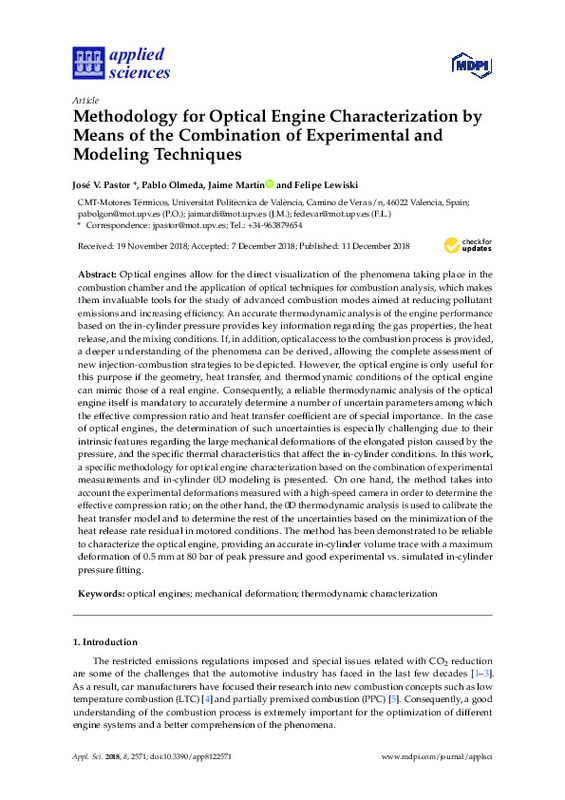JavaScript is disabled for your browser. Some features of this site may not work without it.
Buscar en RiuNet
Listar
Mi cuenta
Estadísticas
Ayuda RiuNet
Admin. UPV
Methodology for Optical Engine Characterization by Means of the Combination of Experimental and Modeling Techniques
Mostrar el registro sencillo del ítem
Ficheros en el ítem
| dc.contributor.author | Pastor, José V.
|
es_ES |
| dc.contributor.author | Olmeda, P.
|
es_ES |
| dc.contributor.author | Martín, J.
|
es_ES |
| dc.contributor.author | De Vargas Lewiski, Felipe
|
es_ES |
| dc.date.accessioned | 2019-06-21T20:01:08Z | |
| dc.date.available | 2019-06-21T20:01:08Z | |
| dc.date.issued | 2018 | es_ES |
| dc.identifier.uri | http://hdl.handle.net/10251/122500 | |
| dc.description.abstract | [EN] Optical engines allow for the direct visualization of the phenomena taking place in the combustion chamber and the application of optical techniques for combustion analysis, which makes them invaluable tools for the study of advanced combustion modes aimed at reducing pollutant emissions and increasing efficiency. An accurate thermodynamic analysis of the engine performance based on the in-cylinder pressure provides key information regarding the gas properties, the heat release, and the mixing conditions. If, in addition, optical access to the combustion process is provided, a deeper understanding of the phenomena can be derived, allowing the complete assessment of new injection-combustion strategies to be depicted. However, the optical engine is only useful for this purpose if the geometry, heat transfer, and thermodynamic conditions of the optical engine can mimic those of a real engine. Consequently, a reliable thermodynamic analysis of the optical engine itself is mandatory to accurately determine a number of uncertain parameters among which the effective compression ratio and heat transfer coefficient are of special importance. In the case of optical engines, the determination of such uncertainties is especially challenging due to their intrinsic features regarding the large mechanical deformations of the elongated piston caused by the pressure, and the specific thermal characteristics that affect the in-cylinder conditions. In this work, a specific methodology for optical engine characterization based on the combination of experimental measurements and in-cylinder 0D modeling is presented. On one hand, the method takes into account the experimental deformations measured with a high-speed camera in order to determine the effective compression ratio; on the other hand, the 0D thermodynamic analysis is used to calibrate the heat transfer model and to determine the rest of the uncertainties based on the minimization of the heat release rate residual in motored conditions. The method has been demonstrated to be reliable to characterize the optical engine, providing an accurate in-cylinder volume trace with a maximum deformation of 0.5 mm at 80 bar of peak pressure and good experimental vs. simulated in-cylinder pressure fitting. | es_ES |
| dc.language | Inglés | es_ES |
| dc.publisher | MDPI AG | es_ES |
| dc.relation.ispartof | Applied Sciences (Basel) | es_ES |
| dc.rights | Reconocimiento (by) | es_ES |
| dc.subject | Optical engines | es_ES |
| dc.subject | Mechanical deformation | es_ES |
| dc.subject | Thermodynamic characterization | es_ES |
| dc.subject.classification | MAQUINAS Y MOTORES TERMICOS | es_ES |
| dc.title | Methodology for Optical Engine Characterization by Means of the Combination of Experimental and Modeling Techniques | es_ES |
| dc.type | Artículo | es_ES |
| dc.identifier.doi | 10.3390/app8122571 | es_ES |
| dc.rights.accessRights | Abierto | es_ES |
| dc.contributor.affiliation | Universitat Politècnica de València. Departamento de Máquinas y Motores Térmicos - Departament de Màquines i Motors Tèrmics | es_ES |
| dc.description.bibliographicCitation | Pastor, JV.; Olmeda, P.; Martín, J.; De Vargas Lewiski, F. (2018). Methodology for Optical Engine Characterization by Means of the Combination of Experimental and Modeling Techniques. Applied Sciences (Basel). 8(12):1-17. https://doi.org/10.3390/app8122571 | es_ES |
| dc.description.accrualMethod | S | es_ES |
| dc.relation.publisherversion | http://doi.org/10.3390/app8122571 | es_ES |
| dc.description.upvformatpinicio | 1 | es_ES |
| dc.description.upvformatpfin | 17 | es_ES |
| dc.type.version | info:eu-repo/semantics/publishedVersion | es_ES |
| dc.description.volume | 8 | es_ES |
| dc.description.issue | 12 | es_ES |
| dc.identifier.eissn | 2076-3417 | es_ES |
| dc.relation.pasarela | S\383212 | es_ES |








